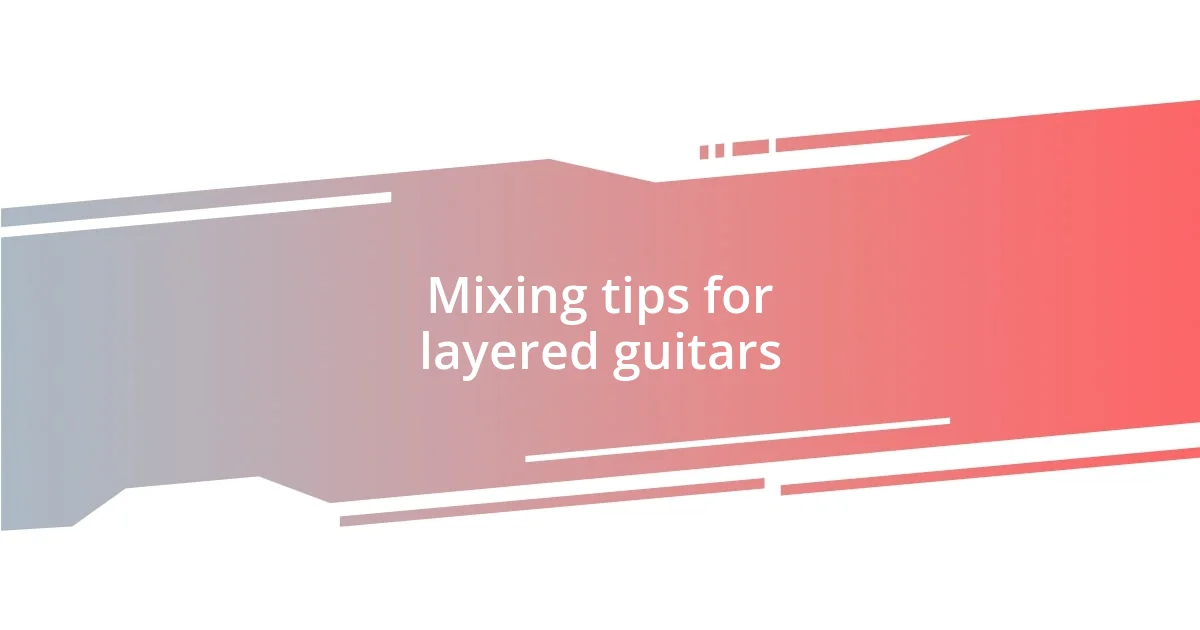Key takeaways:
- Layering guitar tracks enhances the musical texture, requiring attention to frequencies and emotional connection to achieve a cohesive sound.
- Proper setup, including tuning and selecting the right gear, is crucial for a smooth recording process, impacting the overall creativity and quality of layered tracks.
- Effective mixing involves balancing levels, appropriate use of effects, and trusting one’s ears, ensuring that all guitar parts complement each other without overshadowing any elements.

Understanding guitar track layering
Layering guitar tracks can truly transform a song, creating a richer soundscape that captivates the listener. I remember the first time I layered multiple guitar parts; I was surprised at how each added layer brought out new textures, almost like painting with sound. Have you ever felt how a single strum can change with just a slight variation in timing or tone?
When I work on layering, I often start with a rhythm guitar track to establish the foundation of the piece. Then, I add lead lines or complementary melodies, and I cannot stress enough how crucial it is to pay attention to the frequencies of each track. This prevents muddiness in the mix, allowing each part to shine through. Have you ever struggled with conflicting sounds while layering? I know I have, and learning to balance them has been an essential part of my growth as a guitarist.
In my experience, creating a cohesive sound while layering requires not just technical skill but also a certain emotional connection to the music. I find that exploring different combinations can lead to unexpected and delightful outcomes. It’s like discovering hidden gems that were always there, just waiting for the right moment to shine. What’s your favorite combination when layering guitar tracks? I’d love to hear how you approach this creative process!

Preparing your guitar setup
To prepare your guitar setup for layering, I believe having the right environment and equipment is vital. I always ensure my guitar is in tune and that I’ve warmed up properly; there’s something about that initial connection with my instrument that sparks creativity. It honestly makes a difference, especially when I’m laying down those first tracks.
Here are a few essential steps I take:
– Tune your guitar: I use a reliable tuner to make sure everything is pitch-perfect.
– Choose the right gear: Depending on the sound I’m going for, I pick the appropriate guitar and amplifier settings.
– Set up your recording space: A quiet area, free of distractions, helps me focus better.
– Check cables and connections: I can’t count the times I’ve wasted time diagnosing a sound issue that was just a loose cable.
– Adjust headphone levels: Finding the right balance helps me hear all parts clearly while recording.
Taking the time to set up properly can make your layering experience so much smoother and more enjoyable. Just like preparing for a performance, a solid setup lays the groundwork for a stellar recording session.

Choosing the right guitar tones
Choosing the right guitar tones can immensely affect how your layered tracks come together. Based on my experience, I’ve found that starting with the primary tone sets the stage. For instance, if you choose a bright, clean tone for your rhythm track, it can provide a crisp foundation. On the other hand, a warm, overdriven sound could evoke a different emotional response, making your lead lines feel more powerful. It’s fascinating how slight changes in tone can shift the overall vibe of a song, don’t you think?
As I layer tracks, I’m often reminded of the importance of experimenting with different pickups and effects. I’ve found that switching the pickup position on my guitar can drastically alter the tone, creating unique layers that enhance the song’s texture. Additionally, I’ve learned to incorporate effects pedals wisely. For example, a subtle reverb can add depth, while a chorus pedal can create a lush, shimmering layer. Have you explored various effects to find that perfect sound? I encourage you to dive into it – the results can be astonishing.
I’ve also noticed that context matters when choosing tones. When I recorded a piece for a documentary, I opted for a clean, airy sound that complemented the visuals beautifully. In contrast, for a rock anthem, I leaned into fuller, heavier tones. Each project demands a thoughtful approach to tone selection, which ultimately transforms how the listener connects with the music. So, what kind of tone do you usually gravitate toward during your layering sessions? I’m always curious to learn from fellow musicians!
| Tone Type | Applications |
|---|---|
| Clean | Bright rhythms, light melodies, atmospheric parts |
| Overdriven | Powerful leads, classic rock elements, emotional depth |
| Distorted | Heavy riffs, modern rock, aggressive sounds |
| Ambient | Soundscapes, cinematic pieces, experimental layers |

Recording multiple guitar layers
Recording multiple guitar layers can be an exhilarating journey, offering a canvas to express my creativity. I often start by tracking a foundational rhythm part. It’s fascinating how each layer I add builds upon that initial rhythm, breathing life into the entire track. For instance, I once laid down a driving rhythm followed by delicate arpeggios, and the contrast truly sparked a dynamic interplay that I didn’t anticipate. Have you ever experienced that thrilling moment when a track evolves right before your ears?
As I record each layer, I pay attention to the arrangement and space each part occupies in the mix. I’ve found that it’s crucial not to overcrowd the sound; sometimes, less really is more. During one session, I was tempted to add yet another lead line, but I resisted, and it turned out to be a great decision. That decision allowed the first two layers to shine, creating a haunting melody that resonated with listeners. Have you ever pulled back and let simplicity guide your recordings?
Listening critically during playback is another essential aspect of layering. I always take notes as I go, jotting down thoughts on what works and what doesn’t. It reminds me of a session I had where I recorded four layers in one night! When I listened back, I realized that two layers really stood out but the other two were muddying the mix. In that moment, I learned the value of being both a player and a producer. What about you? Do you have any strategies that help you maintain clarity while layering your guitar tracks?

Techniques for blending guitar tracks
Blending guitar tracks is an art that can make or break a song. One technique I swear by is panning different guitar parts across the stereo field. For example, I often pan my rhythm guitar slightly to the left and my lead lines to the right. This not only creates space but also allows each part to breathe, giving the mix a more three-dimensional feel. Have you ever noticed how a well-panned mix pulls you in, almost making you feel surrounded by sound?
Another essential technique involves adjusting the volume and dynamics of each layer. Initially, I was hesitant to experiment with volume levels, thinking louder always translated to better. However, I’ve learned that subtle adjustments can bring out the emotional heart of the piece. During one session, I found that lowering the volume of a melodic line allowed the harmony to shine through, creating a perfect contrast that resonated deeply. Have you ever had that serendipitous moment where turning down a track opened up a new world of possibilities?
Lastly, don’t underestimate the power of EQ during the blending process. I often find that certain frequencies may clash or overpower others, which can muddy the mix. By applying a bit of cut on the competing frequencies of each layer—say, reducing the mids on one track while boosting them slightly on another—I can carve out spaces for each guitar to thrive. It’s like sculpting a piece of art; every move informs the overall composition. Have you experimented with EQ to find your sweet spot?

Mixing tips for layered guitars
When mixing layered guitars, it’s crucial to remember the importance of balance. I’ve gotten caught up in emphasizing one part and forgetting how it interacts with the others. For instance, during a recent project, I overemphasized a bright lead guitar, thinking it would shine through. Instead, the rhythm guitar was nearly lost in the mix. This taught me that every part deserves its moment in the spotlight. Have you ever over-mixed a section only to realize later that you overshadowed other essential elements?
Using effects tastefully is another tip that enhances mix clarity. I once experimented with reverb on multiple tracks and ended up drowning out the core sound. It was a lesson learned! Now, I apply it sparingly, often just enough to add depth without losing the essence of each layer. It’s about finding that sweet spot—what can you do to maintain presence while enhancing the vibe? That’s what makes the mixing process so exciting.
Finally, I suggest trusting your ears! I remember a session where I turned off the visual meters and just listened. The result? I discovered that my instincts about which layers fit well together were spot-on. Sometimes we rely too heavily on the technology instead of embracing our creative intuition. Have you ever had that moment when you let music guide your decisions? It feels liberating!

Finalizing your layered guitar sound
Finalizing your layered guitar sound is often where the magic truly happens. I remember a time when I spent hours perfecting the final mix, only to realize that the small details mattered most. I always focus on subtle nuances, like a slight delay on one of the guitar layers, which can actually add a sense of depth and richness to the overall sound. Have you noticed how a minor tweak can elevate the emotional impact of your music?
Moreover, I believe in taking a step back after mixing and listening to my track on different speakers or headphones. This practice opened my eyes to a mix I thought was perfect, yet it fell flat on consumer-grade headphones. I suddenly understood the importance of how our listeners interact with sound. It’s a reminder that the finalization process is not just a technical task; it’s about connecting with your audience. How do you ensure your music resonates with others?
Lastly, I can’t stress enough the importance of stepping away for a bit. When I’ve been too immersed in the details for too long, my ears can get fatigued, and I start to lose perspective. I make it a point to take breaks and revisit my work with fresh ears. Sometimes, I’ll even set the project aside for a day or two. That distance often brings invaluable insights. Have you found that stepping back allows you to hear your mix with renewed clarity?















